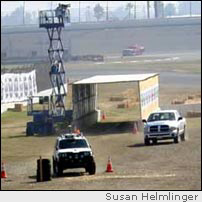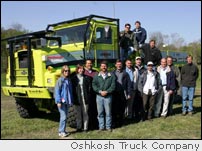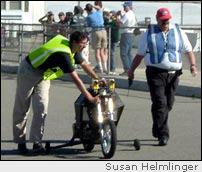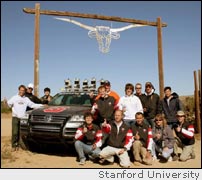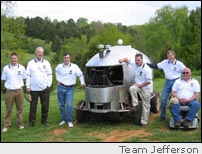Getting
Out There: |
Directory of all "Getting Out There" Articles> |
The
'Bots Are Back in Town
The
DARPA Grand Challenge 2005
by Mark Sedenquist
|
| More coverage of the race: 2005 DARPA Grand Challenge in Primm, Nevada by Mark Sedenquist Winning Strategies by robot analyst Mark Helmlinger Race Reminiscences by Megan Edwards |
The Defense Advanced Research Projects Agency (DARPA) operates under the auspices of the United States Department of Defense. Last March, DARPA sponsored an event called the Grand Challenge, which was held to accelerate the development of autonomous vehicle technologies for use in battlefield situations. To succeed in the Grand Challenge, autonomous vehicles must be able to navigate a 175-mile desert topography course in under ten hours with no assistance of any kind from their human engineers.
This year, the vehicles range from modified dune buggies, motorcycles, four- and six-wheel drive trucks, golf carts, ATVs, and SUVs to some custom designs that fall outside all ordinary automotive categories. The robotic vehicles are fed GPS coordinates a couple of hours before they are launched. They then have to be able to use these coordinates in conjunction with on-board sensory equipment to make decisions about how fast to drive, which route to choose, and how to avoid obstacles. The GPS coordinates plot a top-secret course that will force the vehicles to enter tunnels, travel through mud, climb steep hills, and navigate around other natural and physical barriers.
For this year's Grand Challenge, development teams from twenty-six states completed 79 applications last October. In June, forty teams qualified as semi-finalists, and in July, nine teams were identified as alternate semi-finalists. In August, that alternate field was reduced to three, so that a total of 43 teams traveled to the California Speedway in Fontana to participate in the weeklong National Qualifying Event (NQE) beginning on September 27th.
At the NQE, the vehicles had to autonomously navigate a challenging three-mile course that included a tunnel, zig-zags around power poles, a stretch of rough road, 90-degree turns, steep hills, and a speed run down the infield of the Speedway. At the conclusion of the NQE, a total of twenty teams will travel to Primm, Nevada, for the start of the 2005 Grand Challenge at 6:00 a.m. on Saturday, October 8th. The teams will leave the launching area at timed intervals and will be followed by chase vehicles driven by professional off-road drivers. Provided by SCORE International Off-Road Racing, the skilled drivers help ensure public safety as these unmanned vehicles careen off into the desert.
Spectators are welcome at both the NQE and the Grand Challenge. Large video screens will be set up at the launch area in Primm (forty miles south of Las Vegas at the California state line) to follow the progress of the race. More information about the course and the competing teams is available on the Grand Challenge Web site.
RoadTrip America reporters and analysts have been attending the NQE and will also attend the Grand Challenge. We'll be providing information about the race and some of the participants over the next couple of weeks. As of October 1st at 5:00 p.m., the top ten teams at NQE (those that had completed the course in the fastest time and cleared the most obstacles) were: Stanford Racing, Team Cornell, Desert Buckeyes, Princeton, Mojavation, Red Team Too, Red Team, CIMAR, Team TerraMax, and Intelligent Vehicle Safety Technologies I.
Mark Helmlinger, RTA's Grand Challenge analyst, has designed robotic vehicles for NASA and is currently building radiometric sensing equipment for Northrop Grumman. He has "handicapped the field" and chosen the following teams as his "Picks" to win this year's event:
|
Mark Sedenquist
October 2, 2005
(Links updated August 8, 2020, RTA)

